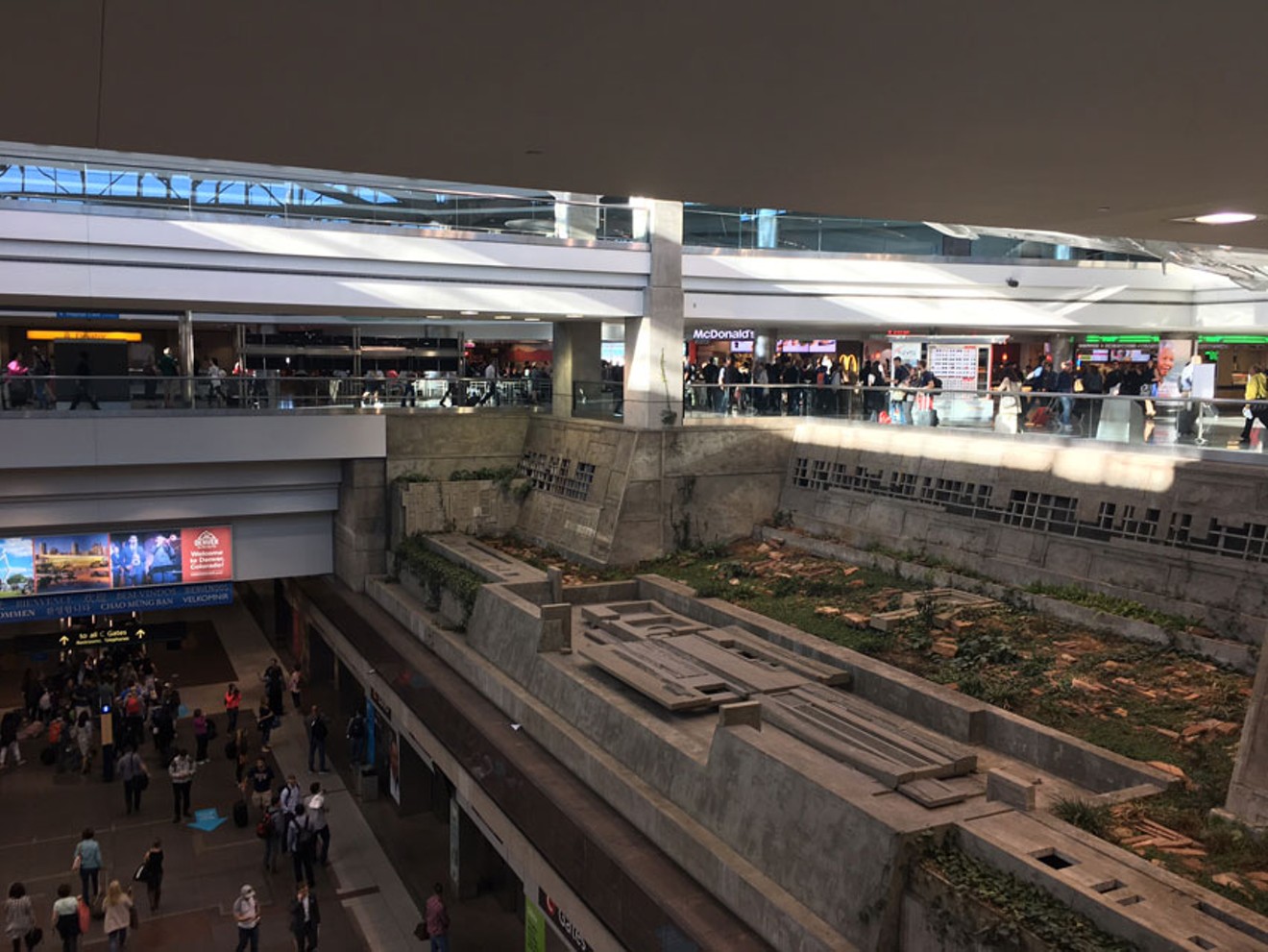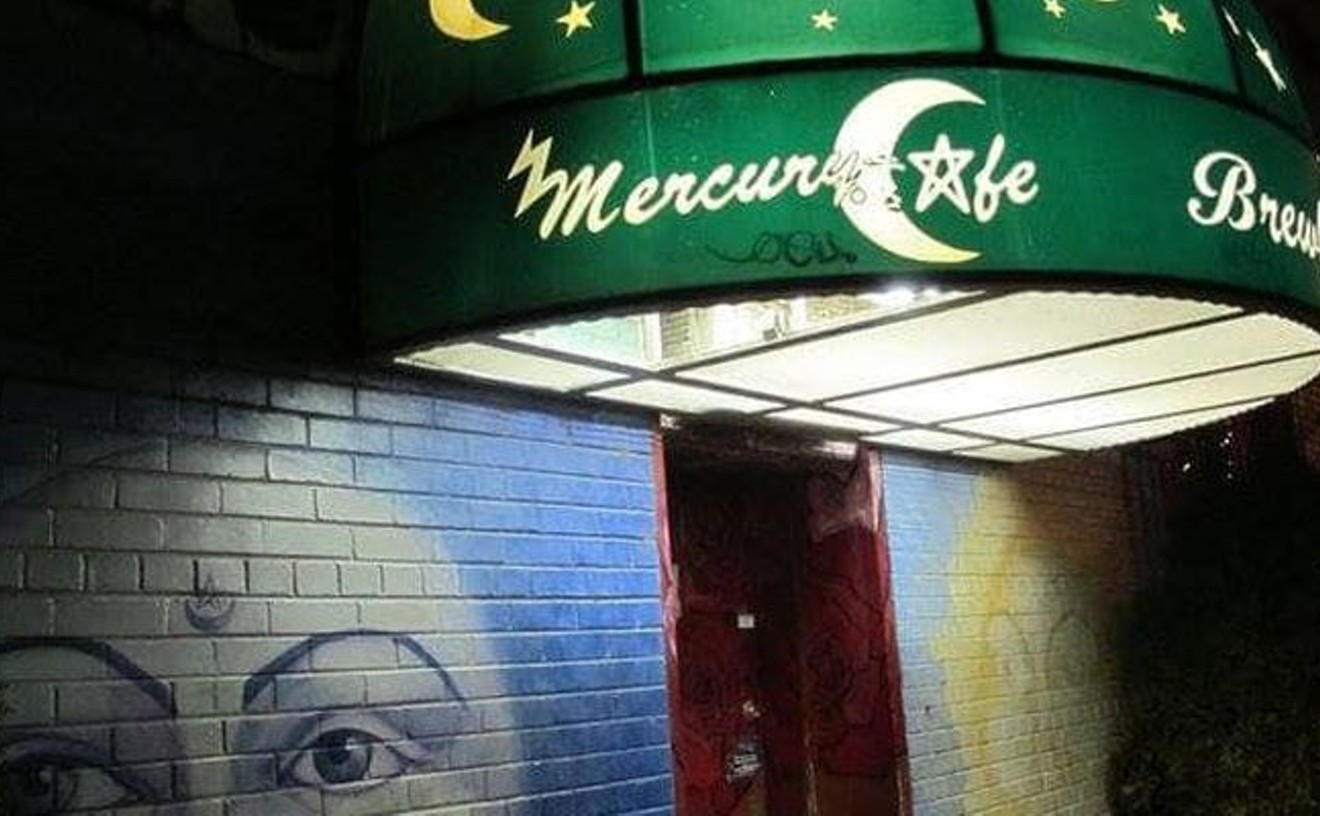Michael Singer, the artist who created “Interior Garden,” was back in Denver last week, to talk about a possible commission for the Denver Zoo. Considering that Denver International Airport officials had just requested that his 22-year-old piece at DIA be deaccessioned, he must be a pretty good sport. He even flew in to Concourse C, where “Interior Garden” is at the core of an area that’s home to booming Southwest, today the airport’s second-largest carrier…and one in dire need of more space, according to the airport.
As Singer made his way to the Mile High City, the Denver Commission on Cultural Affairs was discussing DIA’s request, first introduced on April 4, that three pieces at the airport be deaccessioned: “SkyDance,” the Great Hall floor and “Interior Garden.” The commissioners had little problem agreeing that “SkyDance,” a rooftop-projection piece that had never functioned since it was commissioned more than two decades ago and whose creator, Anna Murch, is no longer alive to suggest changes, could go — though they were clearly sorry that things hadn’t worked out for this ambitious work. The decision on the floor in the terminal’s Great Hall was more wrenching; the airport says that major renovation plans make it impossible for the design to stay, and its creators, Jaune Quick-to-See Smith and Ken Iwamasa, agree. Since the city’s deaccessioning policy calls for removing all parts of a commissioned artwork and either destroying them or returning the remains to the original artists, that means the entire floor will be ripped up. And replaced with? That has yet to be revealed, though it looks like passengers will be emerging right in the middle of the terminal once that pesky TSA screening process is relocated.
The terminal renovation project — still vague in details, but apparently designed to mine travelers’ pockets in a very Colorado way — is slated to begin this fall, which gave the deaccessioning request for the first two pieces some urgency. Not so for Singer’s “Interior Garden.” In its initial report to the commissioners, the airport had made much of the fact that the piece is leaking, that $800,000 has already been spent to repair a work commissioned for $415,000, and that ongoing maintenance — much less an actual fix — will be expensive; at the May 2 meeting, endangering the public was added to its alleged fatal flaws.
Still, much of the discussion this round focused on space — or lack thereof. Stacey Stegman, the airport’s senior vice president of global marketing, back to talk about the deaccessioning request and to answer commissioners’ questions, pointed out that air travel is growing — up from 31 million passengers passing through DIA in 1995, its first year, to 58 million today — and explained that the airport needs more space to feed all those hungry travelers no longer served on board, who carry more baggage than travelers did when DIA was envisioned nearly thirty years ago. The airport especially needs space on the C Concourse, she said, which has less room per passenger than A or B; right now it’s 50,000 square feet short. Construction on five or ten more gates for Southwest will begin in early 2018, but that won’t solve all the problems. “More people are going to be coming up,” Stegman noted. (I’d like to know how they’re going to be coming up from the train: Even when they’re both working — and they’re not now — the two escalators to C are limited in the load they can carry. Maybe DIA wants to replace the Singer with an oh-so-Colorado zipline into the concourse?)
If the commissioners were frustrated by a lack of concrete plans about the terminal project, they were particularly stymied by the information gap surrounding the Singer. Had the airport worked with the artist to adapt the piece? Perhaps the tropical plants Singer initially envisioned that had become an expensive, hand-watering nightmare could be replaced with xeriscaping? That hadn’t been discussed, Stegman acknowledged. And then there was the sorry state the piece has been reduced to, which makes “Interior Garden” look far more like a ruin than originally intended. A decade ago, the airport’s art department had gotten the piece into what it considered good, workable shape. And now? “Until you bring a hammer to this piece of art, it’s your obligation to maintain it,” said commissioner Rick Griffith, who’d been charged with making sure the city’s public-art policy, adopted back in 1988 when the city approved dedicating 1 percent of all major construction-project budgets to art, was followed.
And if that hammer comes down, there’s still the cost of ripping out the piece: While at one point Singer had estimated that “Hidden Garden” could be fixed for good for $250,000, ripping it out would cost at least half a million. And that total doesn’t include the floor by the train, which is also considered part of the work.
The public art at the heart of all three concourses has become as iconic as the tent roof, noted Michael Chavez, Denver’s Public Art Program manager at Arts & Venues, who was there to offer his department’s take on the request. (The airport's Art and Culture Program is an "extension" of the downtown program and works with it "collaboratively," Stegman says, but technically falls under airport management.) “If there are spatial problems at the airport, this isn’t going to solve it,” Chavez said. “It’s very dangerous to consider without enough answers, explanation of options.”
And the commissioners agreed, voting fifteen to three against deaccessioning the Singer. Their vote, and their recommendation that the airport reach out to Singer on possible collaborative fixes, now moves on to Arts & Venues director Kent Rice, who makes the ultimate decision. In the meantime, the public can weigh in, too: Signs at the airport and on flydenver.com describe the deaccession plan and how to provide input through May 16.
The airport wants to put more commercial ventures at the core of the concourse, which comes into conflict not just with the space occupied by “Interior Garden,” but with its goal of creating a “contemplative” space for travelers. If it ultimately goes, the airport has promised to spend the amount of the original contract on replacement art, as it will do with “Skydance” and the Great Hall floor, adding to the 36 pieces in its current, $15 million-plus portfolio. And more pieces will come as the airport expands.
“Art is a priority, and we are doing much more than abiding by 1 percent,” Stegman had told the commissioners. “But art is difficult sometimes.”
Difficult and challenging. It’s art, not a travel pillow.
Contemplate that.
[
{
"name": "Air - MediumRectangle - Inline Content - Mobile Display Size",
"component": "12017618",
"insertPoint": "2",
"requiredCountToDisplay": "2"
},{
"name": "Editor Picks",
"component": "17242653",
"insertPoint": "4",
"requiredCountToDisplay": "1"
},{
"name": "Inline Links",
"component": "18838239",
"insertPoint": "8th",
"startingPoint": 8,
"requiredCountToDisplay": "7",
"maxInsertions": 25
},{
"name": "Air - MediumRectangle - Combo - Inline Content",
"component": "17261320",
"insertPoint": "8th",
"startingPoint": 8,
"requiredCountToDisplay": "7",
"maxInsertions": 25
},{
"name": "Inline Links",
"component": "18838239",
"insertPoint": "8th",
"startingPoint": 12,
"requiredCountToDisplay": "11",
"maxInsertions": 25
},{
"name": "Air - Leaderboard Tower - Combo - Inline Content",
"component": "17261321",
"insertPoint": "8th",
"startingPoint": 12,
"requiredCountToDisplay": "11",
"maxInsertions": 25
}
]














